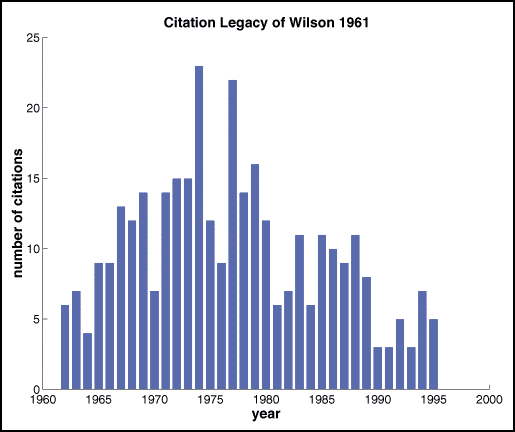

The Science Citation Index lists 338[1] citations for the Wilson 1961 paper, an average of about 10 per year. The paper was first cited the year after its publication (1962) and has been cited every year since then. The number of citations peaked in the mid 70's and has been on a steady decline since then. In fact, on the average the paper has only been cited about 4 times per year in the 90's.
In addition to the quantitative data above, it's interesting to qualitatively look at who in what field has referenced this paper. Since it would not be feasable to analyze all 338 references, a sample had to be taken. In an effort to also try to detect historical trends, all the references from the years 1970, and 1980, and 1990 were looked at in detail. Below is a brief summary for each year.
1970
Seven papers referenced the Wilson 1961 paper
in 1970. Of these, six dealt with a specific species and behavior
(motor patterns in crickets, response to wing-nerve stimulation in the
locust, locust antennae-wind sensitivity, locomotion in deafferenated
toads, flight motor neurons in the Bombus Californicus and Oncopeltus
Fasciatus, motoneurons in the cockroach). One was a general/review
paper on the functional organization of invertebrate ganglia.
1980
Twelve papers referenced the Wilson 1961 paper
in 1980. Of these, three dealt with a specific species and behavior
(wing muscle motoneurons in the cricket, infant locomotion, CPG-mediated
swimming in Tritonia). Six papers dealt with general issues concerning
CPG's and/or rhythmic behavior (invertebrate CPG's - modeling and
complexity, a quantitative model of walking incorporating central and
peripheral influences, neural basis of rhythmic behavior, generation of
rhythmic motor patters, are CPG's understandable?, the history and value
of the CPG concept). The remaining three papers were on topics in a
different field and/or too general to be grouped under the above two
categories (synapse development in adult insects, sensorimotor
integration in the brainstem, neural mechanisms).
1990
Three papers referenced the Wilson 1961 paper
in 1990. Of these, all three focused on a specific species and behavior
(neuronal organization of the flight motor pattern in the cricket,
ongoing motor rhythms in the aplysia, synchronous activity of flight
neurons in the locust).
Several trends can be seen from the above example, although it's not entirely clear if any of these are a function of the small sample size. First of all, of the 12 papers dealing with a specific species, only 3 used the locust (the species used by Wilson). The other species ranged from Aplysia to humans. This can be interpreted to mean that the findings of the Wilson paper apply to a wide variety of species, which tends to lend weight to them.
Another interesting trend is that the percent of the papers dealing with a specific species was 86% in 1970, 25% in 1980, and 100% in 1990. One could make the assumption that papers that refer to a unique species are presenting new research whereas those that don't are general/review papers. This alone doesn't necessarily mean anything, but this evidence could be used to support the claim that CPG-focused research was very active around 1970, had pretty much died down by 1980, but is experiencing a slight revival around 1990. Of course, the sample size is too small and the assumptions too unsubstantiated to actually claim this without further evidence.
